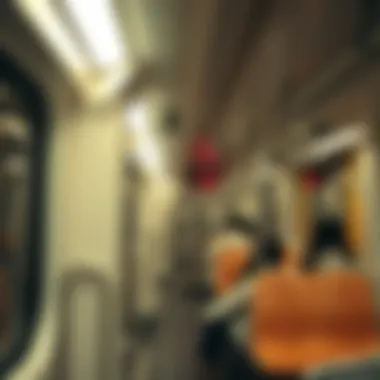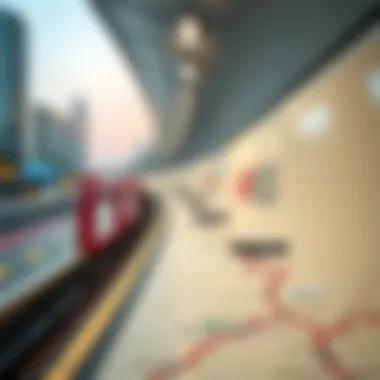Guide to Metro Travel Between Abu Dhabi and Dubai


Intro
The metro system linking Abu Dhabi to Dubai is more than just a public transport facility; it's a lifeline for many commuters and plays a pivotal role in shaping urban development. With the bustling economic activities and growing population in both cities, this transport mode is crucial for enhancing connectivity and convenience. This article takes an in-depth look at the metro system, exploring its routes, ticketing options, and frequency, as well as its far-reaching implications for the real estate landscape.
As cities become more interconnected, understanding the dynamics of this metro journey is essential for various stakeholders including investors, homeowners, and urban planners. The significance of the metro collaboration between these two metropolitan hubs cannot be overstated, and a closer examination will reveal the challenges as well as the opportunities that lie ahead.
Investors and expatriates looking to make informed decisions about their next moves in real estate will find this guide particularly insightful, bringing clarity to not only the journey between Abu Dhabi and Dubai but also the emerging trends that accompany it.
Foreword to the Metro System
The metro system serves as a vital thread in the fabric of urban mobility within the UAE, particularly between Abu Dhabi and Dubai. Understanding this transportation network is crucial, especially for investors, homeowners, expatriates, and real estate analysts. The metro not only underscores the continual growth of these two significant cities but also greatly influences residential and commercial property trends.
Overview of Public Transportation in UAE
Public transportation in the UAE has evolved remarkably over the years. From buses to water taxis, and now the metro, there’s a system in place that aims to alleviate road congestion and promote sustainable travel options. The Abu Dhabi and Dubai metro connects key urban areas, offering a seamless alternative to private vehicles. This is vital in a country where traffic has become a part of daily life for many.
The current public transportation system is characterized by its reliability and efficiency. It’s designed to accommodate a diverse population, which includes locals, expatriates, and tourists alike. Many residents find that relying on public transport not only is cost-effective, but also reduces the stress often associated with driving in busy urban areas. In recent years, the UAE government has invested heavily in expanding the public transport network, with plans to continue enhancing accessibility and convenience for all users.
Importance of Metro Connectivity
Metro connectivity plays a significant role in shaping the urban landscape of the UAE. The direct metro line linking Abu Dhabi and Dubai offers myriad benefits for commuters and stakeholders:
- Ease of Access: Having a direct metro line reduces travel times significantly between these two iconic cities, making it easier for individuals to commute for work or leisure.
- Economic Impact: With improved access comes greater economic opportunities. Businesses can thrive with a larger customer base, and employees benefit from less time spent in transit.
- Urban Development: As metro stations sprout up, nearby neighborhoods often experience a surge in real estate activity. New residential and commercial developments arise, changing the dynamics of property values in those areas.
- Environmental Sustainability: Utilizing the metro rather than personal vehicles contributes to lower carbon emissions, aligning with global efforts to combat climate change.
"A well-connected metro system not only enhances mobility but also transforms communities, stimulating both economic activity and environmental sustainability."
For newcomers and seasoned residents alike, navigating the metro system is a straightforward endeavor. Understanding its importance within the social and economic context of the UAE is fundamental for anyone considering making investments or relocating to the region. With its ongoing expansion and refinement, the Abu Dhabi to Dubai metro serves as a blueprint for efficient modern transport.
Metro Route from Abu Dhabi to Dubai
The route connecting Abu Dhabi with Dubai is more than just a stretch of tracks on a map; it represents a vital artery that interlinks two of the UAE's most significant urban hubs. With the rapid growth in both cities, the metro offers a convenient, efficient means of travel for residents and visitors alike. Not only does it help in easing road congestion, but it also enhances the accessibility of Dubai's cultural, commercial, and recreational offerings for people living in Abu Dhabi.
Starting Point: Abu Dhabi Station
Abu Dhabi Station, the launch point of this journey, is strategically located to cater to commuters from throughout the capital. The station itself is designed with modern facilities that ensure a comfortable experience for passengers. Prior to embarking, travelers can take advantage of amenities such as kiosks for snacks and drinks, waiting areas, and clearly marked signage that offers guidance for both local and foreign passengers.
Moving through the station, riders find a spectrum of transport options, including taxis and buses, that make it easy to reach other destinations after their metro journey. Whether one's destination is a pristine beach or a bustling shopping district, the station connects passengers efficiently to the rest of UAE.
Key Stops Along the Route
As the train rolls out of Abu Dhabi, it’s time to be mindful of the notable landmarks that are quick to pass by. Key stops along the route are essential not just for their proximity to various neighborhoods but also for the opportunities they present for businesses and real estate development.
- Mushrif Park Station: A stop that serves one of the largest parks in Abu Dhabi, ideal for families and nature lovers.
- Al Rahba Station: Known for its residential developments, this area is increasingly popular for those looking to settle in or invest in properties.
- Al Ain Road Station: Here, commuters can connect to various taxicab services and other public transport modes.
Each of these stops acts as a hub, offering schools, supermarkets, and health services nearby. This makes them not only convenient for daily commuters but also appealing for potential investors. The prospect of properties near these stations likely enhances their value due to the increasing demand for accessibility.


Final Destination: Dubai Station
Arriving at Dubai Station is akin to entering a world of possibilities. Positioned in the heart of the bustling metropolis, this station provides immediate access to some of Dubai's major attractions, such as the Dubai Mall, Burj Khalifa, and the Dubai Marina.
Furthermore, the architecture of Dubai Station harmonizes with the city's skyline, reflecting the overall modern vibe that Dubai embodies. Passengers disembarking here will find a seamless integration of the metro with connected services like buses and taxis, ensuring a smooth transition to their final destinations. With numerous shopping and dining options at hand, it's no wonder that this station is a favored stop for tourists and locals alike.
The metro route from Abu Dhabi to Dubai not only serves practical needs but also plays a crucial role in the broader schemes of urban planning and real estate development. As accessibility improves and travel times decrease, the landscape of the housing market in both cities stands to benefit significantly. Residents and investors alike find themselves uniquely positioned to capitalize on the conveniences brought about by this metro route.
Ticketing and Fare Structure
Navigating the metro system from Abu Dhabi to Dubai involves not just knowing the routes but also understanding the ticketing and fare structure. Effective use of the metro facilitates a seamless travel experience, which is crucial for both daily commuters and tourists. A clear grasp of ticket pricing and payment options can enhance the convenience and efficiency of your journey, ensuring you travel without a hitch.
Types of Tickets Available
When it comes to tickets, the metro system offers a variety tailored to meet different passenger needs. Generally, the available ticket types can be categorized as follows:
- Single Journey Ticket: This ticket is suitable for those who are making a one-off trip. It allows for travel between two stations, offering flexibility for short-distance commuters.
- Day Pass: If you plan to hop on and off several times in a day, the day pass provides unlimited travel within a 24-hour period. This option is particularly popular among tourists wishing to explore multiple sites.
- Monthly Pass: For regular users, a monthly pass is economical. It allows unlimited travel for an entire month, making it ideal for daily commuters between Abu Dhabi and Dubai.
- Class Tickets: The metro service differentiates between Standard and Gold Class tickets. Gold Class offers added comfort, typically at a premium fare, perfect for those wanting a more luxurious travel experience.
Fare Comparison: Abu Dhabi vs. Dubai
When looking at ticket prices, it’s evident that fares may vary between Abu Dhabi and Dubai. Typically, fares are calculated based on distance travelled, and this can lead to notable differences.
For instance, a journey from Abu Dhabi may range from AED 7 for a short distance to upwards of AED 30 for longer trips to Dubai. In comparison, journeys within Dubai often start at AED 3 and increase slightly with length. It's crucial for commuters to weigh their options, particularly those who may find themselves travelling frequently between the two locations. This difference can impact daily budgets significantly, especially for businesses and workers operating across both emirates.
Payment Methods and Convenience
The payment methods accepted by the metro system add layers of convenience for passengers. Currently, the two primary options include:
- NOL Card: This rechargeable smart card serves as the backbone of the metro fare system. Not only can it be used for the metro, but it also works on buses, water taxis, and trams, making it a versatile choice.
- Mobile Payments: Many users can also benefit from mobile payment options. Integration with electronic wallets enhances convenience for tech-savvy commuters. However, it’s vital to ensure that your device is armed with sufficient balance or a valid e-payment option before you board.
By understanding these aspects of ticketing and fare structure, passengers can maximize their metro experience while also contributing to the efficient running of this critical transport link between Abu Dhabi and Dubai.
Travel Times and Frequency
Understanding travel times and frequency is pivotal for anyone considering the metro to navigate between Abu Dhabi and Dubai. Time efficiency is a central concern for commuters, investors, and tourists alike, and it directly influences their decisions and experiences. Coupled with the variability in metro frequency throughout the day, these factors shape how travelers plan their journeys.
Average Travel Duration
The average travel duration on the metro from Abu Dhabi to Dubai is roughly 40 to 50 minutes, depending on the specific route, transfers, and waiting times. This time frame might seem brief, especially considering the distance between the two cities, but it's worth noting that such efficiency is largely due to the high-speed design of the metro system.
In practice, the travel time can vary with factors like:
- Time of day: Morning rush hours can elongate travel times slightly, as more commuters hit the metro, especially during weekdays.
- Transfer times: If one needs to change lines or stops, this can also add to the journey. However, the seamless connections typically help in minimizing any disruptions.
The metro service is designed with the traveler in mind. Major stations, such as Sheikh Zayed Road in Dubai and Abu Dhabi’s central station, are equipped with signs and real-time updates regarding train arrival times, further enabling riders to plan effectively. With this knowledge, one can adapt and find ways to adjust their schedules to make the most of their time.


Metro Frequency: Peak vs. Off-Peak Hours
When considering the metro frequency between Abu Dhabi and Dubai, both peak and off-peak hours have significant implications for travel experience.
During peak hours, which typically run from 7 a.m. to 9 a.m. and 5 p.m. to 7 p.m. on weekdays, trains often arrive every 5 to 7 minutes. This efficiency helps accommodate the surge of commuters but can also lead to crowded carriages. Keeping this in mind is essential for those who prefer a more comfortable ride.
In contrast, during off-peak hours, which are usually between mid-morning and earlier afternoon, and after 8 p.m., the train frequency extends to about 10 to 15 minutes. While this may require some patience, the upside is a less crowded environment, often making for a more relaxed commute.
Furthermore, it’s essential to remain aware of planned maintenance schedules or changes in service that may affect frequency. During holidays or events, frequencies can also increase to meet demand, highlighting the dynamic nature of the metro service.
"Optimal planning around metro timing can significantly improve travel quality, especially in bustling urban centers like Abu Dhabi and Dubai."
Impact on Real Estate Market
The intersection of transportation networks and real estate development is a fundamental consideration for any burgeoning city. The metro link between Abu Dhabi and Dubai is no exception to this prevailing principle. Understanding the impact of the metro on the real estate market provides valuable insights for investors, homeowners, expatriates, and real estate professionals seeking to navigate the dynamic landscape of this expanding urban corridor.
Real Estate Dynamics in Proximity to Metro Stations
Just like flowers turning toward the sun, real estate demand flourishes in locations near metro stations. The convenience of having quick, reliable access to public transport can significantly dictate property values and demand. Properties located within walking distance of metro stations tend to witness an uptick in attractiveness for both renters and buyers.
For instance, near stations like the Abu Dhabi Central Bus Station, existing real estate development is on the rise, while plans for new residential and commercial properties are being formulated. This trend offers homeowners an appealing investment opportunity, as access to the metro can enhance the desirability of a location, boosting potential for rental income.
Benefits of Proximity
- Accessible Commutes: Being near metro stations reduces commuting hassles; for many, this translates into a better work-life balance.
- Shopping and Entertainment: Metro stations often attract adjacent commercial establishments, enriching neighborhood amenities and raising overall quality of life.
- Sustainability Factors: Properties near metro stations appeal to environmentally conscious buyers who prefer sustainable transport options.
However, prospective buyers should also be wary. While the proximity to a metro can enhance property value, it could also introduce noise and congestion, elements both detrimental and favorable depending on individual preferences.
Market Trends in Areas Connected by Metro
Metro connectivity has a twofold impact on market trends. First, it can act as a catalyst for development in previously overlooked areas. Neighborhoods that may have languished in demand suddenly become hotspots as developers recognize their potential with metro connectivity. At the same time, existing market dynamics shift as properties in close proximity become increasingly sought after.
Current Market Trends
- Rising Property Values: Areas adjacent to metro stations show a noticeable increase in property values. Investors are keenly eyeing these locales for potential returns.
- Increased Residency Appeal: With ease of commuting, young professionals and expats show higher interest in residing near metro stations, leading to a demographic shift in previously established communities.
- Urbanization: The introduction of metro lines often encourages complementary urban development projects, enhancing local infrastructure such as parks and schools.
The impact of metro connectivity on real estate is profound, often reshaping the urban landscape in ways that reflect both current trends and future possibilities.
Challenges and Limitations
Exploring the metro from Abu Dhabi to Dubai encompasses both exciting prospects and notable hurdles. Acknowledging these challenges is essential for an accurate understanding of how this transport system serves its users, as well as its potential impact on urban development and real estate markets in the dynamic UAE. Foreseeing where improvements can be made isn't merely about enhancement; it’s about ensuring that current and future users have a seamless experience navigating this vital link.
Operational Challenges
Like any urban transit system, the Abu Dhabi to Dubai metro faces operational challenges that can disrupt service. Some of these issues include:


- Maintenance Needs: Regular upkeep is crucial for reliability but can lead to temporary service disruptions. If maintenance schedules are not well-publicized, passengers can find themselves in a bit of a bind.
- Capacity Constraints: Especially during peak hours, trains can feel more cramped than a can of sardines. High demand can stretch the limits of the current services, leading to not just discomfort but also delays.
- Technological Limitations: While the metro employs cutting-edge technology, glitches can still occur. These hiccups can affect ticketing systems, timetable displays, or even train functionality.
Overall, addressing these operational challenges demands consistent investment and efficient management to keep the metro's performance in line with user expectations. Without adaptions and updates, the system risks becoming obsolete, particularly in a rapidly evolving economic landscape like that of the UAE.
User Experience and Accessibility Issues
User experience plays a critical role in the overall effectiveness of the metro system. Here are key considerations that impact riders:
- Accessibility for All: Although efforts have been made to accommodate differently-abled passengers, accessibility is still a work in progress. Elevators and ramps sometimes malfunction, hampering ease of movement.
- Information Clarity: Signage within the metro system isn't always clear. For first-time riders or those less familiar with the area, navigating can feel daunting. Complicated maps or unclear announcements can lead to confusion among passengers.
- Safety and Security: While the metro is generally safe, concerns can arise regarding passenger safety, particularly during late hours. Well-placed security personnel and surveillance are essential to provide peace of mind for riders.
All these user experience elements intertwine, impacting how effectively the metro serves as a link between Abu Dhabi and Dubai. Improving these aspects will be crucial for attracting a broader range of users.
Investing in the metro's operational capabilities and user experience isn’t just about providing a service; it’s about weaving the fabric of a connected urban environment that supports the growth of both Abu Dhabi and Dubai.
For more insights on transportation challenges, visit Wikipedia. To engage with communities discussing these issues, check out Reddit.
Future Enhancements and Developments
The future of the metro link between Abu Dhabi and Dubai holds great promise for enhancing connectivity and addressing the transportation needs of the growing population. This section digs into prospective improvements which are essential for elevating the commuter experience while simultaneously fostering economic growth. As both cities continue to expand, the metro system must evolve and adapt. This is not merely about creating a faster route; it is about optimizing the user experience, safety, and integrating the metro system into broader urban planning initiatives.
Proposed Expansions for Metro Services
With rapid urban development in the UAE, there are significant plans on the table for proposed expansions of metro services. One prominent proposal includes extending the metro lines more deeply into residential and commercial districts. These expansions are crucial in reducing congestion on main roads and minimizing travel time for commuters. For example:
- New Lines: Plans for new lines connecting key areas that currently lack direct metro access, such as the Abu Dhabi International Airport, are being considered. This would serve not only local commuters but also tourists and international travelers.
- Increased Stations: Additional stations are being proposed to better serve the suburbs. This would create accessibility for those who typically rely on personal vehicles.
- Express Services: The introduction of express trains during peak hours can greatly reduce overall travel times. This can especially benefit busy professionals who commute between the two cities.
"Enhanced metro services are critical in aligning with the sustainability goals of the UAE, making public transport a more viable option for all residents."
Such expansions are expected to significantly boost the real estate market, making properties in accessible areas more desirable. Connective infrastructure can easily influence property values, benefitting investors and homeowners alike.
Integration with Other Transport Modes
Integrating the metro system with other forms of transport is crucial for creating a seamless journey for commuters. Currently, many travelers rely on taxis or personal vehicles even after taking the metro, which defeats the purpose of a streamlined public transport system. Addressing this gap involves several key components:
- Bus Networks: Coordinating with bus services to create syncronous schedules helps ensure that metro users can easily transfer to buses without lengthy waiting times.
- Ride-Sharing Services: Collaborations with popular ride-sharing platforms could enable smoother transitions from metro to final destinations, particularly for areas not currently serviced directly by the metro.
- Bike-Sharing Programs: Introducing bike-sharing options at select metro stations encourages multimodal transport, promoting environmental sustainability.
All these aspects contribute to reducing dependency on cars, lessening traffic congestion, and creating a more sustainable urban environment. With these developments on the way, the metro system's role in enhancing mobility in the UAE cannot be overstated. The combination of these enhancements is likely to lead to a more efficient, accessible, and user-friendly transit experience for all.
Ending
Key Takeaways on Metro Connectivity
- Enhanced Accessibility: The metro streamlines travel between major urban centers, making it feasible for professionals to commute. This ease of movement is an attractive proposition for businesses and individuals alike.
- Impact on Real Estate: Properties near metro stations tend to command higher prices, making them prime locations for investment. The accessibility factor is playing a significant role in the value increment of various districts.
- Environmental Benefits: Public transport is not just about convenience; it stays aligned with sustainable efforts. The metro reduces traffic congestion, leading to lower emissions and a healthier urban environment.
The Future of Travel Between Abu Dhabi and Dubai
Looking ahead, the future of travel between these two economic hubs appears promising. As the metropolitan area continues to expand, anticipated enhancements to the metro system will cater to the growing population and increased demand for effective transportation.
- Proposed Expansions: Plans are in place for extending metro lines further into surrounding communities, which will alleviate pressure on existing roads, thus promising to ease commutes in notable ways.
- Integration with Other Modes of Transport: Future enhancements will also focus on creating seamless transitions between the metro and other transport options like buses and taxis. Such integrations will offer travelers better connectivity, ensuring the entire journey is smooth from doorstep to destination.
As the region evolves, ongoing development and improvements in the metro system stand to play a pivotal role in shaping urban growth, investment prospects, and the daily lives of commuters. The insight gained from understanding these mobility advancements will enable stakeholders to navigate this dynamic landscape effectively.







